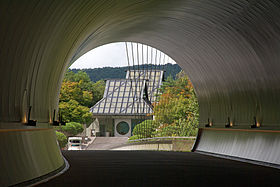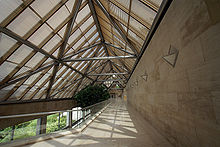- Miho Museum
-
The Miho Museum is located southeast of Kyoto, Japan, near the town of Shigaraki, in Shiga Prefecture. The museum was the dream of Mihoko Koyama (after whom it is named), the heiress to the Toyobo textile business, and one of the wealthiest women in Japan.[1] In 1970 Koyama founded the Shinji Shumeikai spiritual movement which is now said to have some 300,000 members worldwide.[2] Furthermore, in the 1990s Koyama commissioned the museum to be built close to the Shumei temple in the Shiga mountains.
Contents
Collection
The Miho Museum houses Mihoko Koyama's private collection of Asian and Western antiques, as well as other pieces with an estimated value of between US$300 million to US$1 billion,[citation needed] bought on the world market by the Shumei organisation in the years before the museum was opened in 1997. There are over two thousand pieces in total, of which approximately 250 are displayed at any one time.[3]
Architecture
The architect I. M. Pei had earlier designed the bell tower at Misono,[4] the international headquarters and spiritual center of the Shumei organization. Mihoko Koyama and her daughter, Hiroko Koyama, again commissioned Pei to design the Miho Museum. The bell tower can be seen from the windows of the museum.
I. M. Pei's design, which he came to call Shangri-La, is executed in a hilly and forested landscape.[5] Approximately three-quarters of the 17,400 square meter building is situated underground, carved out of a rocky mountaintop.[6] The roof is a large glass and steel construction, while the exterior and interior walls and floor are made of a warm beige-colored limestone from France – the same material used by Pei in the reception hall of the Louvre.
Notes
- ^ "Japan Times". http://search.japantimes.co.jp/cgi-bin/fv20090308a1.html.
- ^ "Encyclopedia of Shinto". http://eos.kokugakuin.ac.jp/modules/xwords/entry.php?entryID=640.
- ^ Reif, Rita (16 August 1998). "ARTS/ARTIFACTS; A Japanese Vision of the Ancient World". The New York Times. http://www.nytimes.com/1998/08/16/arts/arts-artifacts-a-japanese-vision-of-the-ancient-world.html. Retrieved 13 August 2010.
- ^ "Shumei - Art and Beauty". http://www.shumei.org/artandbeauty/misono_tour.html.
- ^ Baker, Kenneth (18 November 2007). "Miho Lets Art Speak For Itself". The San Francisco Chronicle. http://articles.sfgate.com/2007-11-18/entertainment/17270344_1_10th-anniversary-pedestrian-tunnel-objects.
- ^ Rosenblatt, Arthur (2001). Building type basics for museums. John Wiley and Sons. pp. 32. ISBN 0471349151. http://books.google.com/books?id=yTggWMQ42qQC&pg=PA32&dq=shinji+shumeikai&hl=en&ei=Q6BkTOj1N8P98QbMi8XsCg&sa=X&oi=book_result&ct=result&resnum=3&ved=0CDIQ6AEwAg#v=onepage&q=shinji%20shumeikai&f=false.
External links
Coordinates: 34°54′57″N 136°00′57″E / 34.91583°N 136.01583°E
Categories:- Art museums and galleries in Japan
- Museums in Shiga Prefecture
- Civilization museums
- History museums in Japan
- I. M. Pei buildings
Wikimedia Foundation. 2010.



